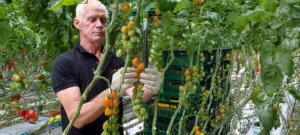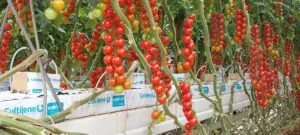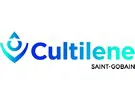Saint-Gobain Cultilene has been involved in a project to implement the Plant Empowerment principles at Tomatoworld since 2020. After an exploratory first season, the second year of the project is characterized by much more stability and predictability. “Now that I’ve got more regularity in the irrigation strategy and more control over the substrate this year, I’m sure the plants will be even stronger and healthier than last season,” says Ab van Marrewijk from Tomatoworld.

Ab van Marrewijk manages Tomatoworld’s 1,200m2 show greenhouse in the Netherlands, where a total of 40 different tomato varieties from five different seed companies are grown for demonstration, education, and research purposes. “It’s my duty to get the very best out of the plants for those companies. The aim is to grow beautiful and high-quality tomatoes with a real ‘wow’ factor,” he states.
Van Marrewijk has been involved in the horticultural industry for several decades and has closely followed the developments around data-driven growing and the Plant Empowerment philosophy. “The focus on optimizing the plant’s natural balances by using data in combination with the laws of physics and plant physiology really appeals to my own way of thinking. When we got a new Hoogendoorn IIVO climate computer in early 2021, I realized that we now had all the necessary information at our fingertips. We were halfway through an existing crop cycle at that time, but I was so keen to explore the effects of Plant Empowerment that I decided to put the principles into practice right away,” he continues. So Tomatoworld installed sensors to measure the EC level inside the slabs and the drain as the basis for gathering and analyzing the irrigation data using the LetsGrow.com platform.
The importance of a good start
Van Marrewijk explains that the substrate is particularly important because the roots provide the foundation for the plant’s performance throughout the season. “I’ve known Saint-Gobain Cultilene for many years, since the early 1980s, and regard them as a very reliable supplier of dependable and well-tested products. Their substrates do exactly what you want as a grower. The roots are a plant’s production hub, but you don’t get good roots automatically. At Saint-Gobain Cultilene, they really emphasized the importance of allowing time at the beginning for the plant and the substrate to ‘connect’ so that the roots become optimally distributed throughout the entire slab,” he says. “Therefore, together with Remy Maat, Application Manager at Saint-Gobain Cultilene, I spent the first six to eight weeks of the cycle focusing on giving just enough water to stimulate the connection and then allowing the plant to build its own ‘factory.’ Our aim was to achieve 50% dry-back but by no more than 2% per day. Although it may feel unnatural for many growers to ‘do nothing’ after the initial watering, this gradual approach really works!”
Insights into the substrate
The watering strategy remains critical after the roots are established, but finding the right strategy is tricky for Van Marrewijk because he has so many different varieties in his relatively small greenhouse. “Some varieties need much more water than others, and the requirement of plants within the same variety can vary depending on their location in the greenhouse and how much sunlight they get throughout the day. I know from experience that a tomato plant can be ruined if I allow it to get too dry just once; even if I water it again afterwards, it’s too late to be rescued. That’s why I always keep a close eye on whether the plants are receiving enough water.” Needless to say, Van Marrewijk was excited to have access to all the sensor data in the first year of the Plant Empowerment project. “Thanks to being able to see precisely what’s happening in the substrate, I could work more precisely in terms of what time I started watering and how long I carried on for. For example, based on measuring the drain, I found out that some plants had got 3.2 liters in the past 24 hours, and other plants had got nothing at all! To compensate for this, I tended to water the plants a bit more at the start of the day and then give them a little bit more at the end of the day, depending on what the data told me,” he recalls.
Defining the irrigation strategy in advance
The project is now in its second year. “One of the biggest differences compared to last year is that I discussed and agreed on the irrigation strategy together with Saint-Gobain Cultilene before the new season got underway in January 2022,” says Van Marrewijk. “So this time, based on analysis of the data from last year, we’ve proactively aligned the watering strategy with the slab type right from the start rather than reactively making decisions throughout the season in response to the real-time data. Needless to say, I’m still able to adjust the irrigation if necessary, but now it’s more a case of fine-tuning things based on what we’ve learned rather than making any major changes.” As a result, the watering is spread more evenly throughout the day in terms of both dose size and regularity, and then the plants are allowed to dry back from the end of the day until the next morning.
Another thing that has been altered this year is the number of drain holes in the substrate. Van Marrewijk: “Last year, we noticed that the EC tended to be a little higher in the corners of the slab. During our discussions with Saint-Gobain Cultilene before the season started, we decided to see if we could solve this by increasing from one drain hole in the middle of the slab to three or six evenly spread drain holes. This has made it easier to increase or reduce the EC as needed, creates more uniformity in the drain, and just generally gives us better control over the slab.”
Stronger plants all season long
According to Van Marrewijk, the Plant Empowerment principles make the plants stronger and robust enough to last all season long, which is especially important at Tomatoworld: “This season started on 20 January and will continue until the end of November. In fact, last year, some companies asked me to extend the season until 10 December. Towards the end of the season, it becomes even more critical to avoid over-watering because you want to keep enough oxygen in the substrate, which is full of roots by then. Now that I’ve got more regularity in the irrigation strategy and more control over the substrate, I’m sure the plants will be even stronger than last season, so they will still look fantastic in December if necessary.”
Combining experience to achieve a better product
As part of the Plant Empowerment project, the irrigation strategy is viewed in the wider context of all the plant balances, and Saint-Gobain Cultilene works in conjunction with the other Sustainable Integrated Growing Solutions (SIGS) partners as part of a multidisciplinary team. “Remy visits us frequently, often with other SIGS partners. We’re like one big family who regularly get together to discuss ideas, provide advice and share details of our research findings. It’s about combining our experience to achieve a better product together,” states Van Marrewijk. “Now that we have strong roots and ever-more data at our fingertips, we’re looking forward to implementing the other Plant Empowerment principles – such as screening, ventilation, and lighting – to get even more out of our tomato plants without pushing them past their limits, of course. That will be a great result for us – but based on what we’ve seen here, I firmly believe that the Plant Empowerment philosophy can help growers everywhere to optimize production levels in combination with fewer inputs. Therefore, on a much larger scale, our industry as a whole has a real chance to contribute to tackling global challenges such as climate change and feeding the growing population,” he concludes.
For more information:
Cultilene
cultilene.com
